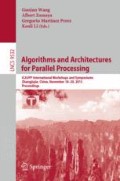Abstract
Underwater Sensor Networks (UWSN) provide a promising solution for aquatic applications. Localization in Mobile Underwater Sensor Networks is very challenging because of the harsh environmental characteristics and limitations of radio communication. Minimization of energy utilization is another critical issue in UWSN domain. Hence, networking protocols with least communication overhead are desirable. In this paper, we propose a single anchor node based localization scheme to minimize communication packets required for location estimation. A sensor node estimates its location using Time of Arrival and Angle of Arrival measurements. Location of mobile anchor nodes is updated periodically by adopting the mobility pattern of particles in ocean waves. We analyzed the performance of the scheme with real geographic coordinates of different locations in the Arabian ocean collected using Google Earth. Experimental results showed that the proposed method provided better performance for short range sensor nodes.
Access this chapter
Tax calculation will be finalised at checkout
Purchases are for personal use only
References
Akyildiz, I.F., Pompili, D., Melodia, T.: Underwater acoustic sensor networks: research challenges. Ad Hoc Netw. 3, 257–279 (2005)
Cui, J.H., Kong, J., Gerla, M., Zhou, S.: The challenges of building mobile underwater wireless networks for aquatic applications. IEEE Netw. 20, 12–18 (2006)
Erol, M., Vieira, L.F., Caruso, A., Paparella, F., Gerla, M., Oktug, S.: Multi stage underwater sensor localization using mobile beacons. In: Second IEEE International Conference on Sensor Technologies and Applications, pp. 710–714. IEEE Press (2008)
Erol, M., Vieira, L.F., Gerla, M.: Localization with dive’n’rise (dnr) beacons for underwater acoustic sensor networks. In: Second ACM workshop on Underwater networks, pp. 97–100. ACM (2007)
Gomez, J.V., Sandnes, F.E., Fernandez, B.: Sunlight intensity based global positioning system for near-surface underwater sensors. Sensors 12, 1930–1949 (2012)
Han, G., Jiang, J., Shu, L., Xu, Y., Wang, F.: Localization algorithms of underwater wireless sensor networks: a survey. Sensors 12, 2026–2061 (2012)
Kennedy, M., Koop, S.: Understanding map projections. GIS by Environmental System Research Institute (1994)
Liu, L., Wu, J., Zhu, Z.: Multihops fitting approach for node localization in underwater wireless sensor networks. Int. J. Distrib. Sens. Netw. 2015, 124 (2015)
Mirza, D., Schurgers, C.: Collaborative localization for fleets of underwater drifters. In: OCEANS, pp. 1–6. IEEE Press (2007)
Mirza, D., Schurgers, C.: Motion-aware self-localization for underwater networks. In: Third ACM International Workshop on Underwater Networks, pp. 51–58. ACM (2008)
Munoz, D., Lara, F.B., Vargas, C., Enriquez-Caldera, R.: Position Location Techniques and Applications. Academic Press, London (2009)
Ojha, T., Misra, S.: Mobil: A 3-dimensional localization scheme for mobile underwater sensor networks. In: IEEE National Conference on Communications, pp. 1–5. IEEE press (2013)
Kumar, R., Thakur, N., Thakur, V.: An overview of sonar and acoustic underwater communication. Int. J. Adv. Res. Electrical, Electronics and Instrumentation Engineering 2, 1997–2003 (2013)
Thurman, H.V., Trujillo, A.P., Abel, D.C., McConnell, R.: Essentials of Oceanography. Prentice Hall, Englewood Cliffs (1999)
Veness, C.: Calculate distance and bearing between two latitude/longitude points using haversine formula in javascript (2015). http://www.movable-type.co.uk/scripts/latlong.html. Accessed 13 May 2015
Zhou, Z., Peng, Z., Cui, J.H., Shi, Z., Bagtzoglou, A.C.: Scalable localization with mobility prediction for underwater sensor networks. IEEE Trans. Mobile Comput. 10, 335–348 (2011)
Acknowledgments
The research was financially supported by Higher Education Department, Government of Kerala and the facilities are provided by College of Engineering, Trivandrum, India.
Author information
Authors and Affiliations
Corresponding author
Editor information
Editors and Affiliations
Rights and permissions
Copyright information
© 2015 Springer International Publishing Switzerland
About this paper
Cite this paper
Das, A.P., Thampi, S.M. (2015). Single Anchor Node Based Localization in Mobile Underwater Wireless Sensor Networks. In: Wang, G., Zomaya, A., Martinez, G., Li, K. (eds) Algorithms and Architectures for Parallel Processing. ICA3PP 2015. Lecture Notes in Computer Science(), vol 9532. Springer, Cham. https://doi.org/10.1007/978-3-319-27161-3_69
Download citation
DOI: https://doi.org/10.1007/978-3-319-27161-3_69
Published:
Publisher Name: Springer, Cham
Print ISBN: 978-3-319-27160-6
Online ISBN: 978-3-319-27161-3
eBook Packages: Computer ScienceComputer Science (R0)

